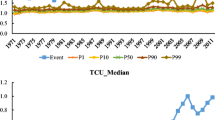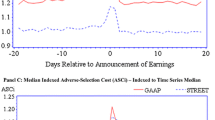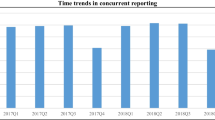Abstract
Landsman and Maydew (J Acc Res 40:797–808, 2002) document that the information content of earnings announcements has increased over the past three decades, and Francis et al. (Acc Rev, 77:515–546, 2002) conclude that expanded concurrent disclosures in firms’ earnings announcements, especially the inclusion of detailed income statements, explain this increase. We posit and find that the temporal increase in the intensity of the market’s reaction to Street earnings offers a competing explanation for the Landsman and Maydew finding. We also find that expanded concurrent disclosure of GAAP-based information contributes to the temporal increase in the information content of earnings announcements. However, unlike Francis et al., we find that the temporal increase in concurrent balance sheet and cash flow statement information dominates concurrent income statement information once we control for Street earnings.
Similar content being viewed by others
Notes
We use “the information content of earnings announcements” and “the informativeness of earnings announcements” interchangeably throughout this paper.
The I/B/E/S Glossary (2000) states that “I/B/E/S strives to report actual earnings as soon as they are released into the market place. For the US and Canada, earnings reports are culled directly from the newswires, adjusted for comparability with estimates and reported to subscribers via the Intra Day Surprise Report, which is delivered five times each trading day (p. 7).”
The subscript t in E_GPit should be interpreted as indicating year-quarter since quarter subscript is omitted for ease of exposition.
An alternative approach to calculate GAAP earnings surprises is to use GAAP earnings in the same quarter of the previous year as earnings expectations. The seasonal random-walk GAAP earnings surprises avoid the problem of a mismatch between actual earnings and earnings expectations and are widely used in accounting research (Francis et al. 2002; Lipe et al. 1998; Teets and Wasley 1996). However, earnings expectations in seasonal random-walk GAAP earnings surprises are stale. Consequently, seasonal random-walk GAAP earnings surprises capture true earnings surprises with errors and are not a perfect solution for the above mentioned measurement error problem.
We thank an anonymous reviewer for pointing out the measurement error problem in FE_GP and suggesting this refined measure of GAAP earnings surprises (FE_GP*).
Our actual earnings (E_GPit and E_STit) and analyst earnings forecasts are all on an unadjusted, historical per share basis in quarter t. Since some firms have stock splits and dividends from quarter t − 1 to quarter t, we adjust the historical stock price at the end of quarter t − 1 to the share basis in quarter t. The adjustment factor for this purpose is the cumulative adjustment factor (Compustat quarterly item #17) in quarter t − 1 divided by the cumulative adjustment factor in quarter t.
We also examine a 7-day window, [−1, +5], around earnings announcement date. The results from the 7-day window are qualitatively identical to those reported in the paper for the 3-day window.
AVARit, by construction, is a non-negative number. When AVARit is less (greater) than one, it indicates smaller (larger) than normal return volatility.
The coefficients on T are also significantly positive when Eq. 2 is estimated separately for each quarter. In addition, we incorporate a calendar year-end dummy variable and its interaction with the time trend in Eq. 2 as in Landsman and Maydew (2002) since the information content of earnings announcements may differ for calendar and non-calendar year-end firms. We estimate this expanded Eq. 2 for the full sample or each quarter separately. None of our findings is qualitatively changed.
They also use the seasonal random-walk difference in quarterly earnings per share before extraordinary items (Compustat item #9) as a second measure of unexpected earnings, with qualitatively unchanged results.
Note that one potential explanation for this temporal decline in ERCs with respect to GAAP earnings surprises is the temporal increase in the measurement error of GAAP earnings surprises noted above. Below, we show that even after controlling for increasing measurement error in GAAP earnings surprises the ERCs decrease over time.
We take a natural logarithm transformation to allow for the possibility that the time trend is non-linear (see Bradshaw and Sloan 2002, Fig. 2).
The market’s reaction to Street earnings surprises contains two components: the coefficient on FE_ST or ABSFE_ST (which is constant over time) and that on FE_STT or ABSFE_STT (which changes over time). The sum of the two coefficients represents the market’s full response. Thus, the coefficient on FE_STT or ABSFE_STT captures the annual increment in the market’s response.
We also estimate Eqs. 4 and 5 using various sub-samples to examine whether the patterns of the market’s return, volume, and return volatility responses to Street and GAAP earnings surprises documented in Table 4 change in these sub-samples. Specifically, we examine six sub-samples: positive GAAP earnings (E_GP > 0), GAAP losses (E_GP < 0), positive Street earnings (E_ST > 0), Street losses (E_ST < 0), Street earnings exceed GAAP earnings (E_ST > E_GP), and GAAP earnings exceed Street earnings (E_ST < E_GP). In untabulated results (a total of 18 regressions), we find that the tenor of Table 4 is unchanged. Specifically, we find that the market’s return and volume responses to Street earnings surprises (i.e., the coefficients on FE_STT and ABSFE_STT) increase over time in all 12 regressions except for the volume response in the sub-sample where Street earnings exceed GAAP earnings (E_ST > E_GP). The market’s return volatility response to Street earnings surprises in general does not change over time except for the positive GAAP earnings sub-sample (E_GP > 0) where we find a significantly positive coefficient on ABSFE_STT. In none of the 16 regressions, do we find that the market responses to GAAP earnings surprises increase over time.
Results are available upon request from the authors.
To increase the chance of finding their earnings announcement press releases, our 58 firms are randomly selected from the top 50% of our full sample in terms of market capitalization. An average firm in this sample, therefore, is larger in size than an average firm in our full sample. This may limit the generalizability of our findings as is the case in Francis et al. (2002).
Some earnings press releases contain only several key line items of a financial statement, instead of a complete or detailed statement. We code these press releases as not containing a detailed financial statement. In addition, we also code the absolute value of a firm’s unexpected sales, ABSUSit, following Francis et al. (2002). However, this variable does not load in our regressions. So, we do not include it in our analyses. Francis et al. (2002) code five additional concurrent disclosure variables. These five variables are all insignificant in explaining increased informativeness of earnings announcements. Moreover, coding these five variables involves a high degree of subjectivity. Consequently, we do not include these five variables in our investigation.
References
Amir, E., Lev, B., & Sougiannis, T. (2003). Do financial analysts get intangibles? European Accounting Review, 12, 635–659.
Bamber, L. S. (1986). The information content of annual earnings releases: A trading volume approach. Journal of Accounting Research, 24, 40–56.
Bamber, L. S. (1987). Unexpected earnings, firm size, and trading volume around quarterly earnings announcements. The Accounting Review, 62, 510–532.
Bamber, L. S., & Cheon, Y. S. (1995). Differential price and volume reactions to accounting earnings announcements. The Accounting Review, 70, 417–441.
Beaver, W. (1968). The information content of annual earnings announcements. Journal of Accounting Research, 6, 67–92.
Bhattacharya, N., Black, E. L., Christensen, T. E., & Larson, C. R. (2003). Assessing the relative informativeness and performance of pro forma earnings and GAAP operating earnings. Journal of Accounting and Economics, 36, 285–319.
Bradshaw, M. T., & Sloan, R. G. (2002). GAAP versus the Street: An empirical assessment of two alternative definitions of earnings. Journal of Accounting Research, 40, 41–66.
Brown, L. D. (2001). A temporal analysis of earnings surprises: Profits versus losses. Journal of Accounting Research, 39, 221–241.
Brown, L. D., & Sivakumar, K. (2003). Comparing the value relevance of two operating income measures. Review of Accounting Studies, 8, 561–572.
Doyle, J. T., Lundholm, R. J., & Soliman, M. T. (2003). The predicative value of expenses excluded from pro forma earnings. Review of Accounting Studies, 8, 145–174.
Francis, J., Schipper, K., & Vincent, L. (2002). Expanded disclosures and the increased usefulness of earnings announcements. The Accounting Review, 77, 515–546.
Gleason, C., & Lee, C. M. (2003). Analyst forecast revisions and market price discovery. The Accounting Review, 78, 193–225.
Gu, Z., & Chen, T. (2004). Analysts’ treatment of nonrecurring items in Street earnings. Journal of Accounting and Economics, 38, 129–170.
Heckman, J. (1979). Sample selection bias as a specification error. Econometrica, 47, 153–161.
Kim, O., & Verrecchia, R. E. (1991). Trading volume and price reactions to public announcements. Journal of Accounting Research, 29, 302–321.
Kross, W., & Kim, M. (2000). Differences between market responses to earnings announcements in the 1990s versus 1960s. Working paper. Purdue University.
Landsman, W. R., & Maydew, E. L. (2002). Has the information content of quarterly earnings announcements declined in the past three decades? Journal of Accounting Research, 40, 797–808.
Lipe, R., Bryant, L., & Widener, S. (1998). Do nonlinearity, firm-specific coefficients and losses represent distinct factors in the relation between stock returns and accounting earnings? Journal of Accounting and Economics, 25, 195–214.
Lo, K., & Lys, T. (2001). Bridging the gap between value relevance and information content. Working paper. University of British Columbia.
Lougee, B. A., & Marquardt, C. A. (2004). Earnings informativeness and strategic disclosure: An empirical examination of “pro forma” earnings. The Accounting Review, 79, 769–795.
Matsumoto, D. A. (2002). Management’s incentives to avoid negative earnings surprises. The Accounting Review, 77, 483–514.
Michaely, R., & Vila, J. (1995). Investors’ heterogeneity, prices, and volume around the ex-dividend day. Journal of Financial and Quantitative Analysis, 30, 171–198.
Payne, J., & Thomas, W. (2003). The implications of using stock-split adjusted I/B/E/S data in empirical research. The Accounting Review, 78, 1049–1067.
Teets, W., & Wasley, C. (1996). Estimating earnings surprise coefficients: Pooled vs. firm-specific models. Journal of Accounting and Economics, 21, 279–295.
Utama, S., & Creedy, W. M. (1997). Institutional ownership, differential predisclosure precision and trading volume at announcement dates. Journal of Accounting and Economics, 24, 129–150.
Acknowledgements
We gratefully acknowledge the helpful comments and suggestions made by Russell Lundholm (the editor), an anonymous referee, Paul Beck, Brian Cloyd, Rajib Doogar, Neil Fargher, Susan Krische, Jeff Miller, James Myers, Theodore Sougiannis, Martin Wu, David Ziebart, and workshop participants at University of Illinois at Urbana-Champaign. We thank Thomson Financial for providing analyst forecast data through the Institutional Brokers Estimate System (I/B/E/S). Dan Collins and Hong Xie thank the Department of Accounting at the University of Iowa and the Department of Accountancy at the University of Illinois at Urbana-Champaign, respectively, for financial support.
Author information
Authors and Affiliations
Corresponding author
Rights and permissions
About this article
Cite this article
Collins, D.W., Li, O.Z. & Xie, H. What drives the increased informativeness of earnings announcements over time?. Rev Account Stud 14, 1–30 (2009). https://doi.org/10.1007/s11142-007-9055-y
Published:
Issue Date:
DOI: https://doi.org/10.1007/s11142-007-9055-y




